Live chat software
Reach your customers instantly via web, mobile, and social on live chat and messaging
A guide to the best live chat software
Last updated April 23, 2024
Businesses should be wherever their customers are, especially when those customers need help. And in the past year, customers have flocked to messaging and live chat apps to request service.
Nearly a third of customers messaged a company for the first time in 2020—74 percent of whom say they plan to continue. And that growth is spread across a variety of channels. From 2020 to 2021, support ticket volume jumped:
- 101 percent on WhatsApp
- 58 percent on Facebook Messenger and Twitter direct messages
- 34 percent over SMS/text
(Source: Zendesk Customer Experience Trends 2021)
In their time of need, customers expect convenience, speed, and personalization from support teams. Live chat software and messaging provide all three. But this isn’t just a win for customers.
The asynchronous nature of messaging eases the pressure on service agents because customers can handle other things (like walking the dog or shopping) while they wait on an agent’s response. This enables service teams to scale up and continue to provide great service—without a ballooning headcount.
Why add live chat to your website?
Adding live chat to your website allows you to meet your customers where they’re most comfortable having a conversation. And more comfortable customers tend to buy more and remain loyal. But adding live chat is about more than just customer preferences.
Provided that your live chat software is deployed within a flexible, quickly deployed, and centralized workspace, live chat website tools are:
- Scalable: One-to-many interactions enables agents to serve multiple customers concurrently.
- Fast: Automated workflows and self-service options enable customers to solve simple issues (i.e. checking a status or balance, tracking or changing an order, etc.)
- Personal: Chatting with support agents feels much more like the back and forth customers have with their family and friends.
On top of all that, adding live chat to your website is quick and easy to implement.
Still, to get the most from your live chat software, it’s not just a matter of plugging it in and you’re off the races. It also needs to work with the people, processes, and tools your agents already use.
Mobile live chat while on the go
Use mobile live chat on iPhone and Android and keep the customer support going with the ability to immediately respond to customer queries. Mobile live chat also allows you to proactively start a chat — think prompting customers to complete a purchase. In fact, customers approached with a chat are three times more likely to make a purchase. Mobile live chat software allows you to track your customers and engage them at just the right moment. Think of it like the friendly and well-informed salesperson that appears in a store exactly when you need them.
So before we get into how to choose the right live chat software, we’ll review the basics—what live chat is, its benefits, and its most essential features. Then, we’ll discuss 13 of the top live chat software tools on the market today and how to choose the best one for your business.
- What is live chat software?
- What are the common features of live website chat software?
- What are the benefits of using a live chat app?
- Live chat software trends
- Top 14 live chat software & apps
- A summary of the top 14 live chat software
- How to choose the best live chat website software for your busines
- Frequently asked questions
- Start with Zendesk live website chat and messaging with a free trial
What is live chat software?
Live chat software is the technology that powers instant messaging platforms through which an organization’s customer service agents communicate with prospects and customers. The platforms allow agents to carry on real-time and asynchronous conversations through a brand’s website, over social media channels (i.e. Facebook Messenger), via text message, or in a company’s mobile app.
More broadly speaking, live chat software is often integrated with chatbots, automation platforms, CRMs, analytics, messaging apps, knowledge bases, help desk software, and more through APIs and native or third-party integrations. These integrations allow live chat apps to:
- Save service agents time and reduce operating costs by deploying chatbots to handle repetitive customer requests, allowing more complicated requests to be handled by live agents.
- Enable companies to provide faster, more personalized services by pulling in relevant data from CRMs and analytics software to trigger workflows and for use by chatbots and live agents.
- Build rapport between company and customers by conducting conversations in the messaging channels customers are most comfortable with (like WhatsApp for Business, Twitter Business, Facebook Messenger for Business, Instagram Direct, etc.).
Put simply, live chat software lets you deliver rich conversational experiences that are connected across your web, mobile, and/or social apps. It's easy to automate and fast to scale for every customer's needs. Also, mobile live chat apps on Android and iPhone keep support going when your agents are on the move.
How does live chat software work?
Live chat software typically works via a chat window, which can take a few different forms. It can be a proactive chat pop-up where a chat box appears on your screen and asks if you need help. You can type inside the box to start the conversation. Many websites also include a button (usually on the bottom right of the web page) that allows customers to initiate the conversion by clicking to connect with an agent.
Companies can also incorporate a chatbot into their live chat strategy to respond to customer requests outside of business hours, collect key customer information upfront, and/or create a ticket that a human agent can pick up when they’re back in the office or finished helping another customer.
Who uses live chat software?
From e-commerce startups to B2B SaaS enterprises, companies across industries can use live chat software to improve the customer experience.
The technology is primarily used to provide customers (and prospects) with instant, 1:1 support without interrupting their browsing flow. In fact, Zendesk Benchmark data shows that customers have been increasingly turning to social messaging apps and live chat for customer service. Twenty-five percent of customers reported using live chat more during the pandemic, sending support tickets surging nearly 50 percent. But organizations also use live chat for automation, lead generation, online forms, and more.
With the power of live chat, your business can:
- Increase sales by proactively engaging customers on your website
- Help more customers in less time and boost satisfaction
- Anticipate customer needs and offer help as soon as they need it
Many businesses that use live chat software are also looking to add to, and improve, their digital service offerings. These companies often prefer live chat to the phone because:
- Live chat is more efficient (and cost-effective); agents can help multiple customers at once
- It’s easier to scale
- It’s easier to analyze chat transcripts
- Teams can provide 24/7 support with the help of an AI-powered chatbot
Customers don’t always want to take the extra step of making a phone call or keep up with the back-and-forth of an email thread. The most adaptable businesses are going where their customers are, adding new channels so customers have convenient options to get help as soon as they need it. Now is the time to follow the lead of these digital-first companies and get serious about conversational business.
What are the common features of live chat software?
There are a few high-level features you’ll typically find with most modern live chat apps.
Just keep in mind that capabilities may be more advanced on some solutions compared to others. Still, you’ll need to know the essential, common features of live chat. So here are the six features to look for and evaluate.
Chatbots
The dirty little secret of live chat website software is that it isn't always “live.” Chatbots are computer programs that can carry out a chat with a customer on your website without a live agent. Chatbots are a natural complement to live chat website apps because they can handle simple and repetitive requests on their own and pass off more complicated requests to live agents which helps teams to scale and serve more customers more efficiently.
Proactive chat (or smart triggers)
Proactive chat allows your agents or salespeople to initiate a chat in real-time with a website visitor. You can also set up triggers that proactively initiate a chat with a customer, which can help encourage and facilitate sales throughout the checkout process.
Smart triggers are predetermined rules that determine what should happen if certain circumstances occur. For example, you could set a smart trigger that causes your website’s live chat window to pop up with a canned message if a website visitor spends a certain amount of time on a certain page.
Canned responses
Canned responses are prewritten sections of text designed to be used in a predetermined situation. Since support agents often face similar situations, they can create canned responses to automatically do things like:
- Greet a returning customer by name
- Offer a discount
- Transfer a chat to another agent
- Answer a common question
Queue management
When all your agents are occupied, queue management allows you to choose how you communicate with and prioritize waiting customers. Queue management capabilities often include:
- Manual or automatic chat routing
- Chatbot messaging with waiting customers
- Setting queue limits to control the size of an agent’s waiting line
Performance Metrics and KPIs
Live chats can generate a treasure trove of data and business intelligence. But you’ll only be able to make sense of it if you can extract insights from how your customers engage with your company. The most essential metrics and KPIs to look for include:
- First response time (FRT)
- Average resolution time (ART)
- Chat to conversion rate
- First contact resolution rate (FCR)
- Customer satisfaction score (CSAT)
- Average wait time
- Missed chats
Advanced Features
As mentioned, the features above are what you can expect to find in most live chat software. But the following are what you can expect from more sophisticated tools:
- Chatbot builders: provide low or no-code tools that allow admins to customize conversation flows for automating web and mobile messaging interactions with your customers, giving them the opportunity to, for example, self-serve their support issues before connecting with agents.
- Rich message types: enable agents and bots to send emojis, GIFs, forms, and carousels to facilitate self-service, collect customer information, communicate more clearly, and express your brand personality.
- Quick replies: provides immediate answers to incoming questions using machine learning to reply with relevant information so customers can get answers without waiting. Answers can be delivered via email, ticket form, live chat, messaging, Slack, API and/or SDK.
- Contextual self-service: a live-chat-embedded help center that suggests relevant articles with the live chat website plugin or widget and mobile SDK.
What are the benefits of using a live chat app?
Provide more context-relevant service at scale
When successfully integrated with chatbots and CRMs, live chat software is unique in that it allows you to engage with prospects and customers in a contextually relevant way at scale.
For example, imagine a customer who’s filled their shopping cart and nearly completed their purchase on your website. Before completing the order, they pause on the checkout page. With a trigger-based chatbot, you could prompt the customer—after a predetermined time—with a message asking if the customer needs any assistance. This allows you to engage with a customer who has shown clear purchase intent.
Plus, because you can set up the chatbot-to-live-chat handover so only customers who request assistance are put in touch with a live agent, you can provide context-relevant service while streamlining staffing costs.
Support prospects and customers at their convenience
Live chat website technology has improved the ability of service agents to support customers at the customer’s convenience. With the right live chat solution, businesses can provide options for customers to:
- Find their own answers (self-serve) with relevant knowledge base content, delivered by a chatbot
- Request to be transferred to a live agent
- Leave a message for customer service
- Continue conversations from where they left off
Also, companies can offer support to customers 24/7 because chatbots and self-serve options are always available. The result of all this? Higher CSAT scores and a support team that can scale to serve more customers, more effectively than ever before.
Increase customer and agent value
According to Forrester, customers who chat with a company convert three times more often than those who don’t. Customers who chat with a company tend to buy on average 10-15% more that other customers.
These stats are a direct reflection of how live chat can increase the lifetime value of your customers. But it’s not just your customers—live chat can make your agents more valuable too. When properly implemented within live chat:
- Chatbots and self-service options filter out easy questions
- Automation handles repetitive logistics (i.e. tagging and routing tickets)
- Chat analytics deliver relevant insights
By filtering out the simple questions, live agents can focus on providing the personalized services that engender the kind of brand loyalty that results in larger purchases and greater sales volume.
Live chat software trends
Here are five live chat software trends to consider when building your live chat strategy.
-
The rise of digital support offerings
Phone-dominant service solutions are no longer sufficient to meet customers’ needs, and the pandemic has only increased their demands for digital support offerings, specifically messaging and chat. In fact, nearly a third of customers messaged a company for the first time in 2020, and 74 percent of those say they will continue to do so.
Customers want a choice of digital channels and get frustrated when the only option is calling and experiencing long wait times. What’s more, resolving support issues via social media can be up to six times cheaper than a voice interaction. Businesses can better meet customers’ needs by providing a choice of messaging, chat, and self-service options upfront and reserving calls for sensitive and complex issues. - Get personal
Seventy-six percent of customers surveyed in our CX Trends Report expect personalized experiences. Here are a few ways you can personalize your live chat conversations:- Put key customer context at agents’ fingertips, such as a customer’s previous support issues, account type, and purchase history. This enables support teams to personalize conversations in real-time.
- Use a chatbot to collect customer information upfront, so agents have all the personal details to resolve the customer’s issue effectively.
- Automatically route customers to the right agent for their issue based on skill, account type, language, and more.
- Automation improves experiences for customers and agents
As messaging rates have risen, so too has the use of AI and automated chatbots. Interactions with automated bots jumped 81 percent in 2020, and they’ve quickly become a vital part of any messaging and chat strategy. Bots make round-the-clock responses possible for customers while freeing up agents to focus on higher-stakes issues. And quick handoffs between bots and their human counterparts mean customers don't have to repeat themselves. - The need for speed
Automated chatbots are just one way to process tickets more efficiently. And 73 percent of customers say quick responses are the top component of a good customer experience. This is especially true for live chat. In addition to chatbots, canned responses and workflow management tools can help teams serve customers faster. - Self-service for the win
Eighty-one percent of customers attempt to take care of matters themselves before reaching out to an agent, according to Harvard Business Review. A chatbot can highlight your self-service options over live chat by recommending help center content to customers and pointing them to quick answers.
Top 14 live chat software & apps
-
Zendesk -
Ada for Chat -
LiveChat -
Acquire -
Genesys DX -
UserLike -
Zoho Desk
-
Podium -
Birdeye -
Drift -
Tidio -
3CX -
ZoomInfo Chat -
ChatSupport
1. Zendesk

Zendesk enables your team to deliver rich conversational experiences across your web, mobile, and social apps so customers can reach you instantly. It's easy to automate and fast to scale for every customer's needs.
With Zendesk, your business can:
- Stay connected on any channel
- Manage all your customer conversations from one place
- Reach out in real-time with proactive engagement
- Enable 24/7 support with automation
- Get more efficient with live chat analytics
- Scale as your team grows
- Customize to the look and feel of your brand
- Do more with your live chat conversations
Stay connected on any channel
Add messaging and live chat to your website or mobile app, and leverage customer presence on various social channels, such as WhatsApp, Facebook, Instagram DMs, and Apple Messages for Business, to deliver instant support without repetition. Provide live chat support for your customers, or continue the conversation when it’s convenient for them—on the channel of their choice.
Manage all your customer conversations from one place
Zendesk brings all your customer interactions into a single view for agents. Agents can seamlessly switch channels and have all the context they need to personalize interactions at scale.
Reach out in real-time with proactive engagement
Customers are three times more likely to make a purchase when you initiate a chat with them. Proactively engage your customers with automated triggers, reduce cart abandonment, and increase conversions.
Enable 24/7 support with automation
Flow Builder is a drag-and-drop tool for designing custom conversation flows that can address your customers’ specific needs. Answer Bot — Zendesk’s AI chatbot — can help customers self-serve by providing direct links to help center articles or hand off the conversation to an agent along with all the context and information the customer has already shared.
These built-in automation tools allow you to provide rich, interactive, and personal conversations with absolutely no coding skills required.
Get more efficient with live chat analytics
Track agent metrics over time to see the impact of wait times and missed live chats. Keep track of all past chat conversations and browse by date, department, agent, visitor, or even a specific tag. Use these insights to anticipate customer needs, increase satisfaction, and improve team efficiency.
With Zendesk, you can monitor metrics in real-time, too. View actionable data on chat volume, visitor experience, and agent performance. Create custom reports and dashboards using live chat metrics relevant to you and get better visibility into performance across all your support channels.
Conversion tracking also lets you measure the positive impact of chat on your bottom line—whether it’s making a purchase or signing up for your product. Use this data to optimize your website conversion funnel and reward high-performing agents.
Scale as your team grows
Delivering quality support while growing your business can be challenging. Zendesk’s sophisticated workflow management features, such as departments, operating hours, and chat routing, make things easier.
Customize
Zendesk provides you with resources to customize your brand’s live chat experience. Build a unique chat experience with the customizable Web SDK. Customize your chat window, add a logo, or change the way it behaves with third-party tools.
Do more with your live chat conversations
Finally, Zendesk’s customizable messaging platform allows you to connect all your business systems to the conversation, from payment processors to third-party bots and AI. You can also unlock advanced capabilities like outbound notifications for proactive customer engagement and group messaging to connect the right people, whether that’s buyers and sellers in a marketplace, or restaurants, customers, and drivers in a food delivery app. However, these advanced capabilities don’t come built into Zendesk live chat (formerly Zendesk Chat); you’ll need to purchase Sunshine Conversations at an additional cost to access these features.
Zendesk’s features include (but aren’t limited to):
- Built-in, build-your-own, and third-party chatbot integrations
- Chat routing and chat queue management
- Canned responses
- Branding customization
- Native integrations to knowledge base, CRM, and other business systems
- Performance metrics (CSAT, FRT, ticket volume, etc.)
- Pre-built analytics dashboards
- Knowledge base management
- Pre-built apps and integrations
- API access
- User authentication and secure access options
- A live chat app to manage conversations on the go
- Proactive messaging
- Offline form
2. Ada for Chat

Ada enables businesses to provide automated live chat, powered by an AI chatbot that goes beyond FAQs. A chatbot that serves FAQs is the fastest and most cost-effective way to automate live chat, but Ada is a good solution for companies looking for a chatbot that’s more specialized because of their niche.
It covers a wide range of industries, caters to small to enterprise-level companies, and supports multiple languages around the globe. Ada’s automation platform acts on each customer's information, intent, and interests with tailored answers, proactive discounts, and relevant recommendations in 100+ languages.
Ada is also the premier chatbot partner for Zendesk. If you’re going to incorporate a chatbot like Ada into your live chat strategy, you’ll need to ensure it integrates with your customer support software. By integrating Ada with Zendesk, teams can ensure seamless chatbot handoffs to live agents—a crucial component of a good live chat experience. They can also manage chatbot conversations alongside all of their other channels and access more advanced routing options and analytics.
Ada’s live chat features include:
- Proactive chat
- Offline form
- Customizable branding
- Integration capabilities
- Routing
- Website visitor tracking
Ada doesn't publicize their pricing information, but you can request a demo from the company for more details. They can build you a custom quote that depends on your business’s needs.
3. LiveChat

LiveChat is cloud-based customer service software with live support, ticketing system, and web analytics capabilities. Like other live chat solutions, LiveChat claims to increase customer satisfaction and sales by reducing the number of customer emails and calls. It also comes with a live chat app. Features include notifications, inactivity messages, chat tags, chat archives, and file sharing
One of the benefits of LiveChat is the integrations it offers. For example, it can create tickets in Zendesk directly from a chat so businesses can easily monitor customer engagement, conduct quality control, and supervise agents. This keeps all your customer insights collected together, extending your customer service capability to manage customer requests.
LiveChat’s live chat features include:
- Proactive chat
- Canned responses
- Offline form
- Customizable branding
- Integration capabilities
- Routing
- Website visitor tracking
LiveChat has different pricing plans based on the features your team needs. Its Starter plan starts at $16 a month per agent, billed annually. But this plan only comes with limited features, such as basic widget customization, and doesn’t include reporting. Its Business plan, which starts at $50 a month per agent, has a longer list of features, including unlimited chat history and advanced reporting. However, messaging channels are still limited. The only social messaging channels LiveChat has an integration with are Facebook Messenger and WhatsApp Business.
4. Acquire

Acquire is a digital customer engagement platform. With features including secure cobrowsing, AI chatbots, live chat, and video calling, Acquire empowers teams to proactively resolve complex sales, service, and support issues in real-time across channels, according to Acquire. Acquire is better known for its chatbot features than its live chat software.
But similar to other live chat software, Acquire enables businesses to collect information 24/7 through forms and enable automation to help boost sales and improve the customer experience. It also has a live chat app. What makes Acquire unique is that you can launch video or voice calls, screen share, and cobrowse right from the messenger.
Acquire comes with integrations, including Zendesk. In the Acquire Zendesk app, you can connect using cobrowse with your users with only a click of a button. You can also automatically sync your Zendesk agents to Acquire as operators.
Acquire live chat features include:
- Proactive chat
- Canned responses
- Offline form
- Customizable branding
- Integration capabilities
- Routing
- Website visitor tracking
Acquire has a few different pricing packages, one for small teams, another for mid-sized and large companies, and a third for enterprise teams. It doesn’t share its pricing on its website, but you can request a quote for the plan you’re interested in.
5. Genesys DX™

Like other live chat solutions on the market, Genesys DX™ promises to empower your business to engage and convert more visitors while boosting support team efficiency and effectiveness. The platform also offers other common live chat features. It enables you to customize the look and feel of your live chat widget and proactively target website visitors. Genesys DX™ also includes surveys to collect contact information before a chat begins and gauge customer satisfaction after the a live chat session.
One unique feature of Genesys DX™ is that you can turn any live chat into a video session for visual demonstrations or consultations. However, reporting is basic. For example, it has limited configuration for specialized reports. It also has limited ability for integration with downstream systems.
Genesys DX™ live chat features include:
- Proactive chat
- Canned responses
- Offline form
- Customizable branding
- Integration capabilities
- Website visitor tracking
Genesys DX™ does not offer a free trial or pricing on its website. However, you can request a demo.
6. Userlike

Userlike is cloud-based live chat software for website and mobile support. It enables teams to message customers in real-time via their website, Facebook Messenger, or Telegram.
Userlike features include the ability to build customized chat buttons and adapt the chat window to fit the look and feel of your website. You can also proactively invite your visitors to chat, switch from customer chats to video calls and screen sharing, set up canned messages for common questions and situations, and receive feedback ratings on your service. However, Userlike does not have a smartphone app for customer care teams to serve customers on the go.
Userlike is chat and messaging software as opposed to ticketing software. As an additional channel, live chat shouldcan be integrated seamlessly into your existing setup of business tools. It’s possible to connect Userlike to external ticketing software through its add-ons or the API. With the Zendesk and Userlike integration, you can convert conversations into Zendesk tickets to keep track of all your customer interactions.
Userlike live chat features include:
- Proactive chat
- Canned responses
- Offline form
- Customizable branding
- Integration capabilities
- Routing
- Website visitor tracking
Userlike offers a free live chat plan, but it only includes four features. You don’t get access to add-ons, WhatsApp, analytics, or many other features needed for a great live chat experience. Userlike also has a Corporate plan, which starts at $290 per month, billed annually. This plan includes features like analytics and live translation, but it does not include full API access. For complete API access, you’ll need to choose the Business plan for $720 a month, billed annually.
7. Zoho Desk
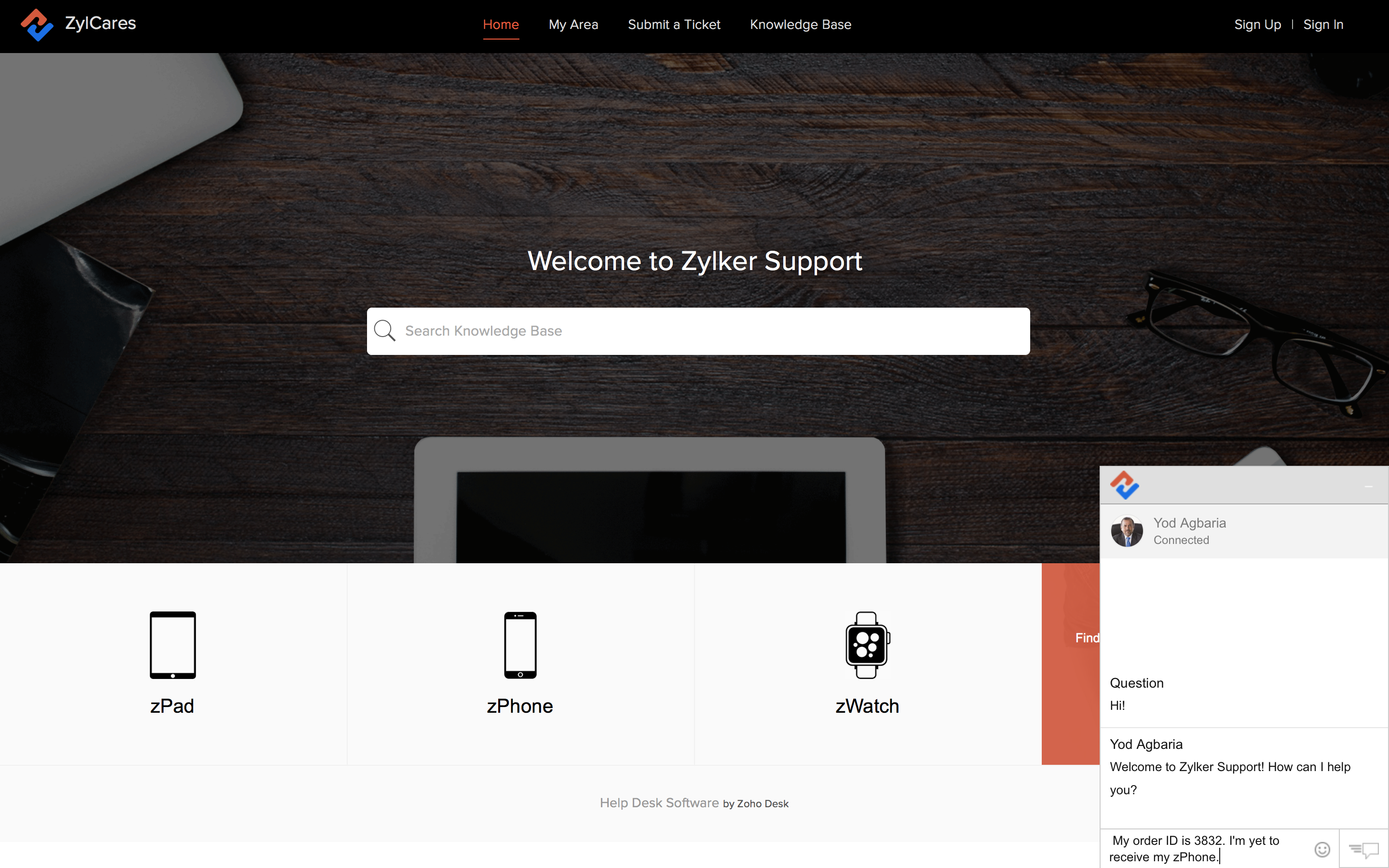
According to Zoho Desk, it enables businesses to respond to customers the minute they reach out with its embeddable chat widget. Features include customer happiness ratings inside the chat window, canned responses, and chat widgets for each of your brands. It has a live chat app.
Zoho also offers a CRM that lets you spot opportunities, be more efficient, and reduce costs while improving your capability as a support agent. You can integrate your Zoho CRM and Zendesk accounts to give your sales and support teams an unhindered flow of information by providing your customer support agents with Contact, Lead, and Potential details straight from Zoho CRM. A support team requires all possible information about their customers, in the proper context, before starting an interaction. The Zoho and Zendesk integrations give information about your Zoho CRM Leads, Contacts, and Potentials inside every Zendesk support ticket.
Zoho Desk live chat features include:
- Proactive chat
- Canned responses
- Offline form
- Customizable branding
- Integration capabilities
- Routing
Zoho Desk lets you try any of its plans for free for 15 days. Its most popular plan, the Professional plan, is $23 per agent per month, billed annually. However, this plan does not include live chat. Live chat only comes with its Enterprise plan, which is $40 per agent per month, billed annually.
8. Podium

Podium’s Interaction Management platform lets you capture leads straight from your website to a text conversation. The most interesting Podium feature is the ability to turn web chat conversations into text messages. However, this also means users are forced to communicate via SMS—even if they want to continue the conversation over your website. Research also shows that customers prefer social messaging channels, like Facebook Messenger and WhatsApp, over traditional SMS.
Benefits of Podium include smart responses to automatically respond to FAQs like business hours or store locations and multi-location transfers to transfer conversations from one business location to another. You also have the ability to customize your chat widget with a greeting, avatar, or after-hours reminder. Podium has a live chat app, too.
Podium live chat features include:
- Proactive chat
- Canned responses
- Customizable branding
- Offline form
- Integration capabilities
Podium has different pricing options. To get specific numbers, you’ll need to fill out a form on Podium’s website.
9. Birdeye
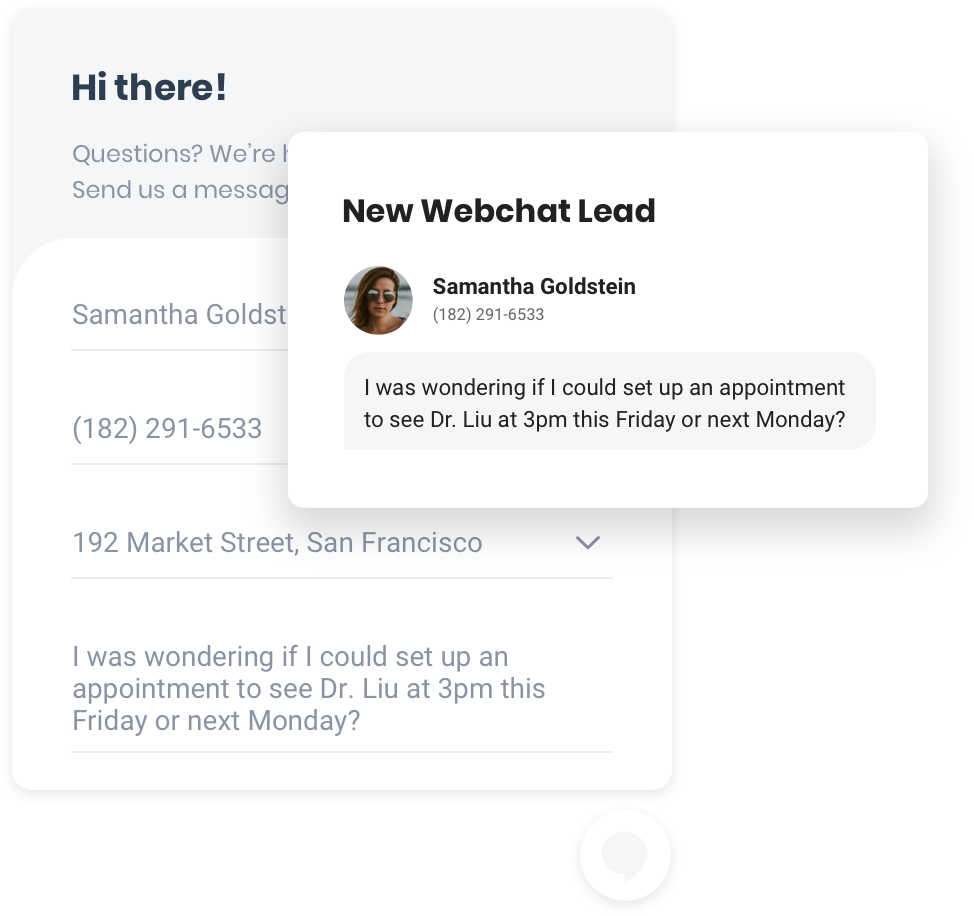
Birdeye Webchat is an all-in-one customer experience and reviews software for multi-location businesses. According to Birdeye, its live chat solution enables companies to engage with website visitors right when they come in. Every conversation starts with a name and a real phone number, so you can focus on closing the deal instead of fishing for contact details.
Webchat allows you to text your leads when they leave your website. It routes messages to their mobile phone, so you don't lose them. You can also customize chat icons, colors, and the greeting and use Google Analytics to understand how website visitors use your webchat. Birdeye also has a live chat app.
Birdeye live chat features include:
- Proactive chat
- Canned responses
- Offline form
- Customizable branding
- Integration capabilities
- Routing
- Website visitor tracking
Birdeye has three pricing plans: a Standard plan, a Professional plan, and a Premium plan, but you’ll need to request specific pricing details by filling out some basic contact information.
10. Drift
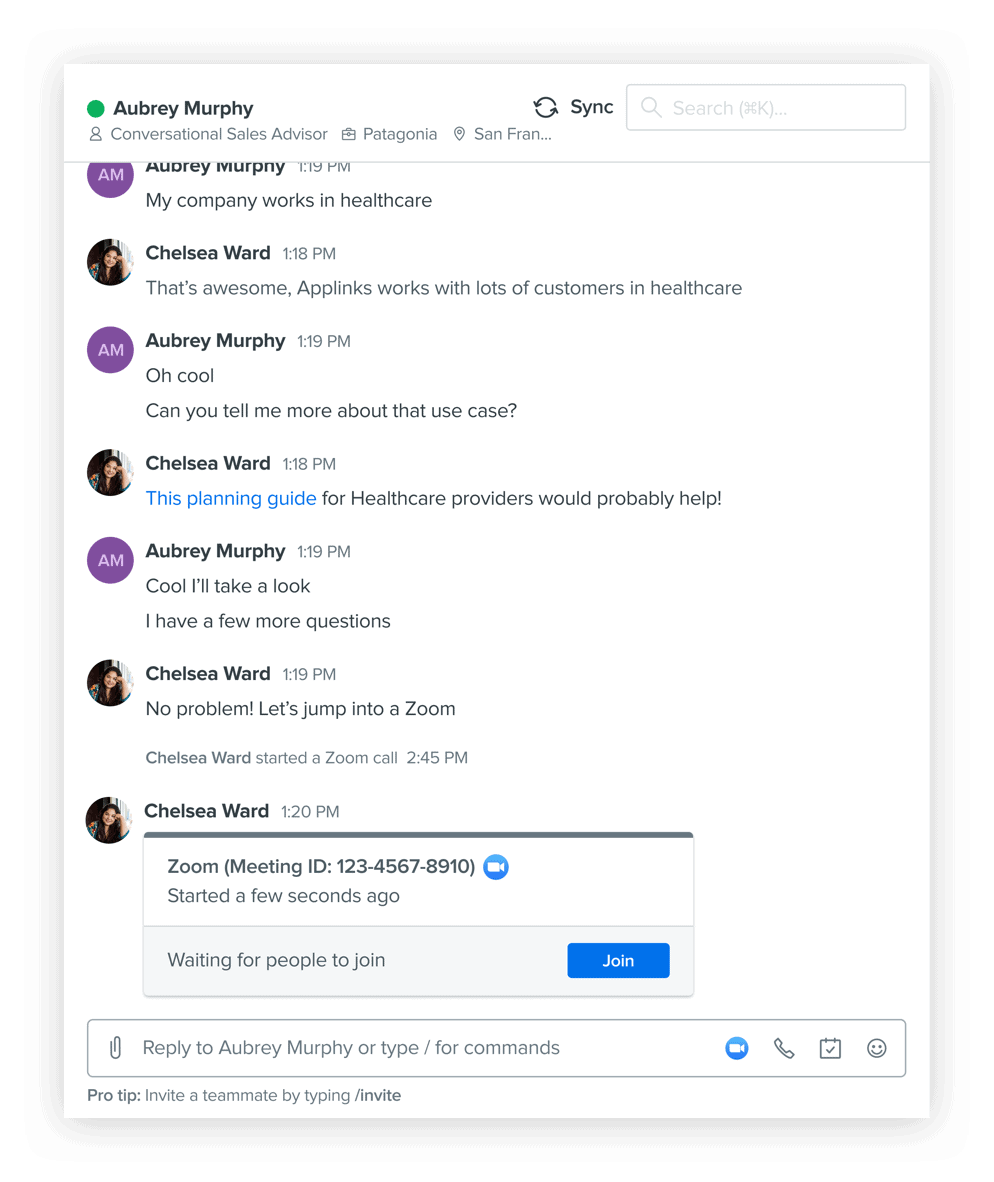
Like most live chat software companies, Drift claims to help businesses engage in real-time, personalized conversations with the right customers at the right time, so they can build trust and accelerate revenue. Unlike most live chat software, Drift doesn’t include forms to collect customer information because it encourages live conversations.
Drift allows you to build playbooks to target open opportunities when they return to your website and route them to their account executive. You can also use Chat to Call or Chat to Zoom to instantly start a phone call with your prospect and qualify them on the spot. Drift’s live chat software will also notify the proper sales representative when one of their target accounts is on the website, so they can jump in to chat. Drift has a live chat app.
Drift live chat features include:
- Proactive chat
- Canned responses
- Customizable branding
- Integration capabilities
- Routing
- Website visitor tracking
Drift offers a Premium, Advanced, and Enterprise pricing plan. You can contact Drift to request specific pricing information.
11. Tidio
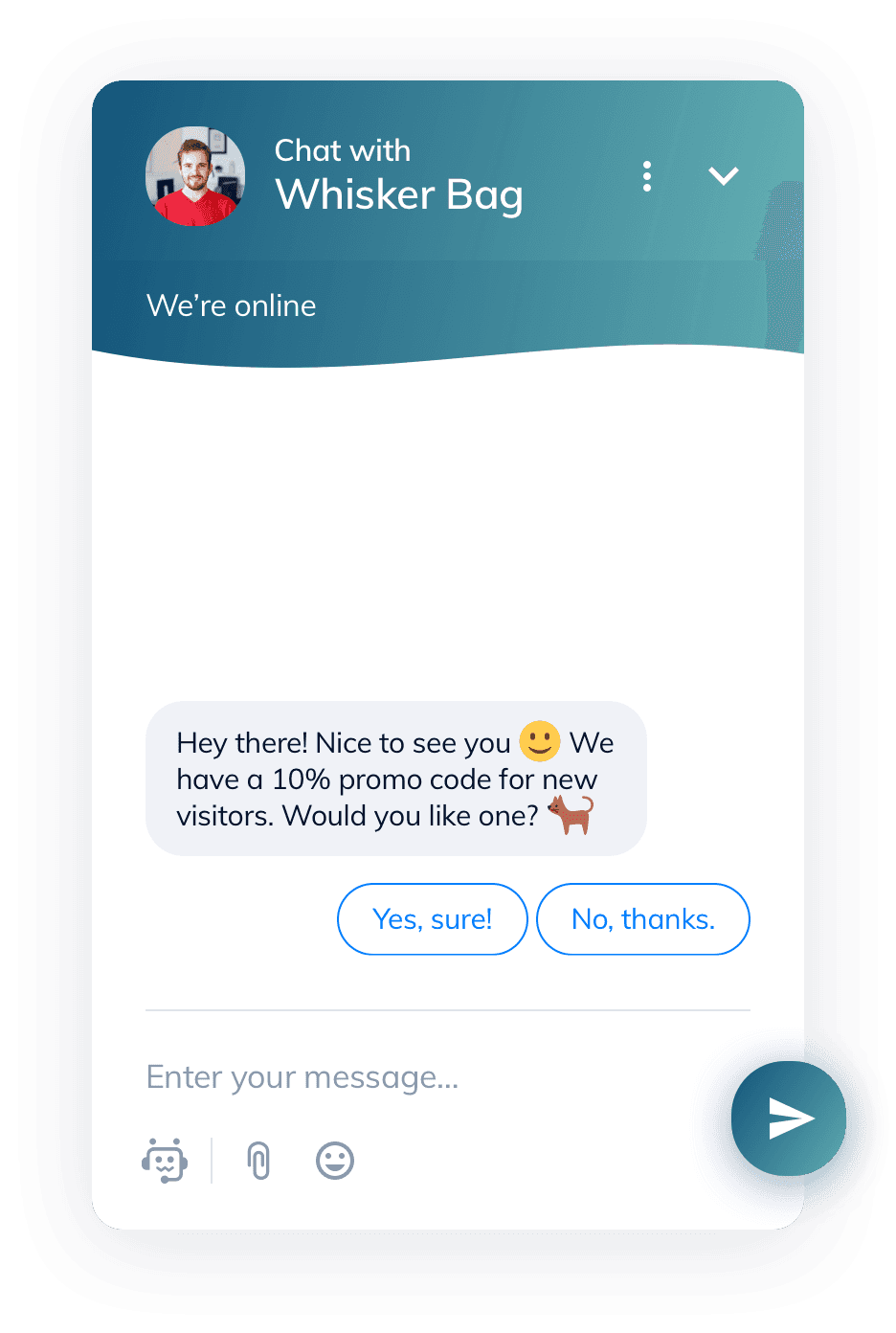
Tidio Chat is a cloud-based live chat system that integrates messages from live chat widgets, emails, and Facebook Messenger. Tidio includes basic live chat features, such as a live chat widget that adjusts to your customers’ screens so they can write to you on mobile or tablet and the ability to connect Tidio to all websites and platforms via dedicated plugins. You can answer repetitive questions with quick reply templates, too.
Tidio enables you to automatically qualify leads and gather visitors’ emails and phone numbers when it comes to your sales team. It also has a live chat app for your agents or sales team. However, Tidio has limited native integrations, and analytics are basic.
Tidio live chat features include:
- Proactive chat
- Canned responses
- Offline form
- Customizable branding
- Integration capabilities
- Routing
- Website visitor tracking
Tidio has four pricing options that come with different features. The first option is free, with limited features. The next plan is $15 a month, billed per operator. There’s also a plan for $25 per month, with three operators available, and a “Chatbot” plan for $39 per month, with three operators available.
12. 3CX
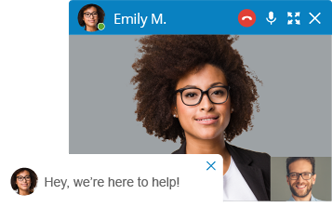
3CX is the developer of the 3CX communications software; the open standards IP PBX which innovates communications and replaces proprietary PBXs, according to 3CX. It offers integrated WebRTC video conferencing, softphones for Mac and Windows, smartphone apps for Android and iOS, and website live chat. It provides basic live chat features such as customized chat greetings according to business working hours and a Facebook and SMS messaging integration. However, integration capabilities and analytics are limited.
A unique feature of 3CX is that visitors can go from chat to voice or video call. Visitors can also click to select which department they want to speak. The interface allows queue-based group handling of chats, and tickets can be assigned to the first user that responds to the chat.
3CX live chat features include:
- Proactive chat
- Offline form
- Customizable branding
- Integration capabilities
- Routing
3CX offers its software for free for the first year. After that, businesses can choose a pricing plan that ranges from $100 to $180 per year.
13. ZoomInfo Chat
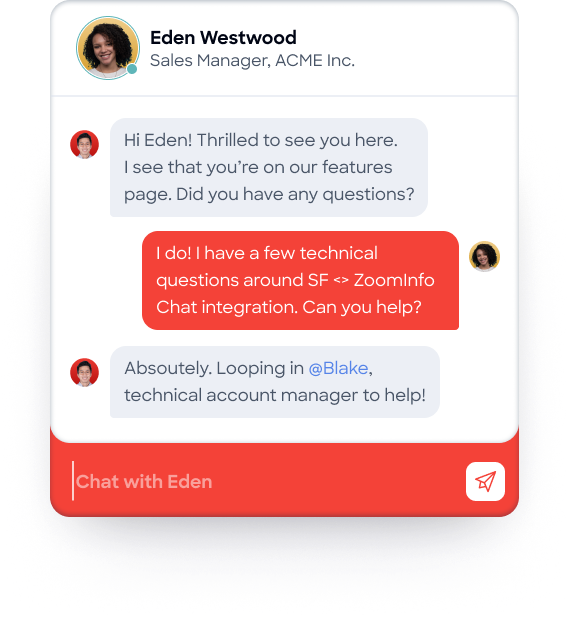
ZoomInfo Chat is a data-powered chat tool that’s developed to qualify and prepare your website visitors for the next step, route more qualified leads to your sales team, and accelerate sales pipeline, according to ZoomInfo Chat. Its platform puts sales and marketing professionals in position to identify, connect, and engage with qualified prospects. It also has a live chat app.
Its live chat solution includes instant alerts for when leads or existing customers are on your website. It uncovers and routes high-value prospects directly to the right representative in real-time. You can automate dynamic interactions based on who the visitor is and how they engage with your website. Its chatbot can schedule meetings and demos, too.
ZoomInfo live chat features include:
- Proactive chat
- Canned responses
- Offline form
- Customizable branding
- Integration capabilities
- Routing
- Website visitor tracking
ZoomInfo Chat has three pricing options, but you’ll need to request a quote for more information.
14. ChatSupport

ChatSupport allows you to engage with visitors in real-time by adding chat prompts to specific pages on your website with a message relevant to the page they are on. ChatSupport is developing a mobile app as well, according to its website. An integration with Zendesk to create support tickets directly from chat conversations is also coming soon.
Features include a lead capture form to gather essential visitor details when you're offline and the ability to personalize your chat widget to match your brand. You can see who's on your website and recognize return visitors to pick up where you left off. ChatSupport includes a post-chat survey form to optimize support by collecting feedback after each conversation, too.
It also allows you to send outbound campaigns to onboard, re-engage, and support specific customer groups. You can install ChatSupport by adding a piece of code to your website.
ChatSupport live chat features include:
- Proactive chat
- Customizable branding
- Offline form
- Integration capabilities
- Routing
- Website visitor tracking
ChatSupport offers a free pricing plan to all new customers.
A summary of the top 14 live chat software
Proactive chat | Canned responses for agents | Offline form | Customizable branding | Integration capabilities | Smart routing | Website visitor tracking | Free trial | |
|---|---|---|---|---|---|---|---|---|
|
|
|
|
|
|
|
|
|
|
|
|
|
|
|
|
|
|
|
|
|
|
|
|
|
|
|
|
|
|
|
|
|
|
|
|
|
|
|
|
|
|
|
|
|
|
|
|
|
|
|
|
|
|
|
|
|
|
|
|
|
|
|
|
|
|
|
|
|
|
|
|
|
|
|
|
|
|
|
|
|
|
|
|
|
|
|
|
|
|
|
|
|
|
|
|
|
|
|
|
|
|
|
|
|
|
|
|
|
|
|
|
|
|
|
|
|
|
|
|
|
|
|
|
|
|
How to choose the best live chat website software for your business
The best live chat website software for your business depends on… your business. Your business model, competitors, customers, governments, and a bunch of other things affect how much value you can get from live chat software.
Rather than trying to wrap your head around so many different factors, focus on these four considerations to guide your purchasing decision:
-
Ability to unify systems, software, channels, and customer data
One of the top reasons companies offer messaging is to provide more contextual, better-informed support, according to companies surveyed in Zendesk’s 2020 Trends Report. Yet, only 35 percent of those businesses are taking an omnichannel approach—one that connects channels, systems, and software to end siloed conversations.
To get the most out of your live chat software, it must be capable of pulling in a single, unified profile of your customer, complete with conversation history and context from any channel. This allows customers to avoid repeating their address or request number while being bounced between different departments or waiting on hold.
And it ensures everyone across your business—including chatbots—has the context they need to create a consistent, personalized experience. - The agent experience
Customer service teams need an intuitive live chat user interface for responding to conversations on the front-end. But having the tools to manage those conversations at scale on the back-end is important too. So the trick is to find the live chat providers that offer both an easy developer experience and a great agent experience.
For instance, the Agent Workspace within Zendesk’s Support Suite equips support teams with the tracking, routing, and collaboration tools needed to close out an issue, live updates about incoming messages, and the ability to seamlessly channel-switch—in other words; an agent can follow-up on a live chat with an email, without ending the messaging conversation.
As businesses introduce chatbots, automation, and multi-department messaging infrastructure, they need a way to centrally define rules of engagement and streamline handoffs between people, automation, and AI across the business. With the help of triggers, automations, and workflows that go beyond ticket-based routing, agents can streamline customer-facing interactions, saving support resources and decreasing time-to-resolution. - Current fit and future scalability
Initial time-to-value and continuous time-to-value are key for creating a seamless customer experience. This is why an open live chat platform that allows your business to both ramp up fast and change quickly is so valuable.
The ideal live chat software is configurable enough to support your existing workflow, powerful enough to handle the most complex business, and flexible enough to scale at any pace.
A partner that’s based on open APIs, like Zendesk’s Sunshine, doesn’t lock a business into using proprietary tech. It lets organizations leverage the technology investments they already made and surface data wherever they want—like their homegrown applications. And developers can use the tools they already know, empowering them to build fast. - Use case
What makes the best live chat software truly “the best” depends on how you plan to use it. As you evaluate your options, ensure your software fits your use case by considering the following questions:
How many participants will you need in a single conversation?
Modern customer relationships often include multiple parties inside and outside the business. For example, marketplace companies may need to connect buyers with sellers and support agents. Most live chat software offers one-to-one communication: the key is to find one that’s also successful at one-to-many.
Do you plan to offer self-service?
Businesses can integrate chatbots for self-service at scale, enabling customers to find answers on their own, in context, around the clock. Businesses should look for live chat apps that give them the ability to launch a bot across multiple channels and the flexibility to avoid being locked into a specific set of integrations or capabilities.
How can you brand the messaging experience?
With the help of SDKs for web and mobile, you can build in-app live chats on any device to drive engagement within the products and services your customers use every day—such as on the web, Android, or iOS—using rich content types like GIFs and location sharing.
Frequently asked questions
Start with Zendesk live chat with a free trial
Because customers engaged in live chats are more likely to make a greater volume and value of purchases, we’ve made our focus to make it as easy as possible for customers and agents to engage with Zendesk live chat software. Zendesk makes your customers feel heard.
Dive in deeper
Adding live chat and messaging can take your customer service to the next level. Learn more about the endless possibilities with Zendesk.
